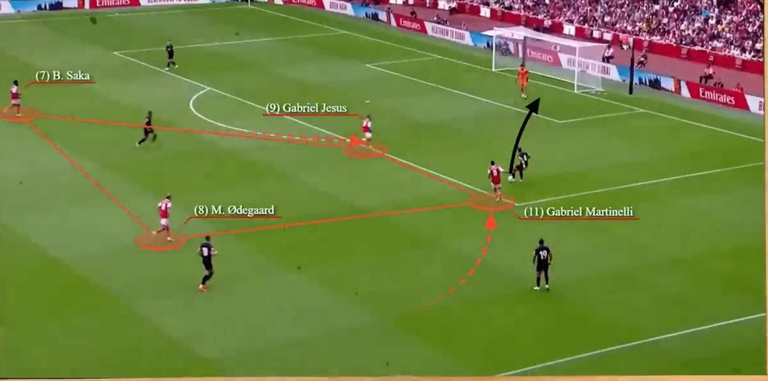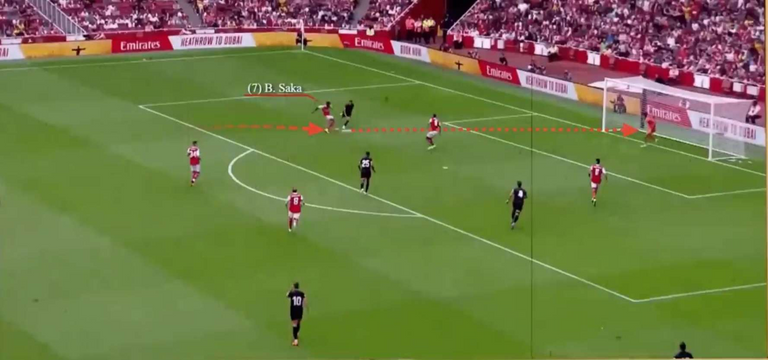Operation Arteta: Pressure
Arsenal was struggling with the pressure off the pitch, I talked about it here. But, more importantly, maybe, Arsenal was struggling on the pitch as well.

Improving and its patterns are often the first thing to do when you're just starting as a coach in a new team. The reason for that is creating a pressure style that suits the team is easier than attacking, or more accurately, a build-up play style. Pressure on the pitch is less demanding of work from the coach, attacking isn't. In other words, destroying is easier than building. That's why when Erik ten Hag started with Manchester United, his priorities were creating a team that's better defensively.
Before Arteta started with Arsenal, Arsenal had conceded 28 goals in 15 matches, with only one clean sheet. The team was getting 5 shots target or more at least in 60% of those 15 matches. In Arteta's first 15 matches, the team conceded 12 goals and had 7 clean sheets. It's a huge improvement but Arsenal was still far from being top-level as 12 goals are still a lot.
Unlike how it seemed, Arsenal had high pressure as its priority when Arteta first started. But, considering how tight the schedule is with the number of matches, that was almost impossible to improve. It should be pointed out that Arteta's first two matches at the Emirates stadium were against Manchester United and Chelsea. That's when the habit of pressuring high in the first half and parking the bus in the second came. Then came the pandemic.
After matches returned after the lockdowns, Arsenal improved a lot with pressure under Aubameyang's leadership. Also, the pressure was improved and became more consistent once Arteta resorted to having formations with three centre-backs. While it definitely fixed the problems in the back when it came to high pressure, it created other problems.
New Problems Arose
Having a three at the back creates a problem as it holds you down to having three attacking players. That means fewer players up front for the opponents to get through as they only face three players when they have 4 at the back most of the time, 5 if the goalkeeper was good with his feet. Also, that's problematic against teams with centre-mid players who move around a lot. Let me elaborate.
Let's say Arsenal was playing 5-2-1-2, 3-5-2, 3-4-3, or call it whatever you want. Arsenal could run into a team often playing 4-3-3 or 4-2-3-1 during the build-up. This means you'd have 2 players up front marking the centre-backs, and another to mark the player in the defensive midfielder, or whoever usually moves the ball from defence to attack.
To put it in Manchester City terms, Arsenal would be okay marking Ruben Dias, Laporte, and Rodri, but once Kevin De Bruyne or Bernanrdo Silva drop to take the ball, or even worse, both, Arsenal's midfielders would be lost not knowing whether to follow or not. This means that whatever advantage Arsenal gained led to a severe loss up front and with the quality of defenders Arsenal had at the time, they needed that advantage.
This Is Where Martin Ødegaard Comes In
In order to make a proper team pressure work, you need to switch to a form of 4-2-3-1, this is not something I am theorizing as this is also the lesson Pep Guardiola learned once Arteta left and was replaced with Juan Manuel Lillo. By the way, Juan Manuel Lillo is basically the inventor of 4-2-3-1 and he first used it to counter Cruyff's dream team which had Pep Guardiola in it. 4-2-3-1 allows you to have 4 players up front to cover the opponent's depth and sides.
Martin Ødegaard's biggest contribution to the squad was something intangible, the way he looks didn't make it so apparent. Not only was Martin Ødegaard pressuring fiercly but also had a big role in guiding and instructing his teammates. This was seen more clearly during the end of last season and early into this season.
Example
Excuse the poor editing here but here's an example of what I was saying in Arsenal's preseason game against Sevilla
Once Sevilla's right-back received the ball, Gabriel Martinelli started running toward. This led to Ødegaard, while marking Sevilla's number 6, to instruct Jesus to close the space between the two center-backs.

Why would Ødegaard do that? We can see why here.

The right-back realized there were no solutions, so, he passed to the center-back. Since Jesus had closed the space between the center-backs, this meant he needed to pass it to the keeper. The keeper had two options then, either give a long pass or pass it to the other center-back.

Check out Saka's body language after reading that the keeper was going to pass it to the center-back. Saka was ready to pounce before the pass is even made, he gained a second by watching the keeper's body language instead of waiting for the pass. You can compare it to the second picture.
Saka intercepted the ball and shot it directly but missed.

The fact that a shooting opportunity was created through Sevilla's right-back having the ball is what matters here. Goals come and go, but having a specific, fruitful, pressure style is the goal of any modern coach. Arteta's style was a 4-2-3-1 that turned into a 4-4-2 when Ødegaard joins Jesus up front.
In Conclusion
It's understated how much coaches need specific players to apply their ideas. The decisions are very situational and Arteta can't lay down every possible scenario to the players, that's actually Pep Guardiola's weakness. At a certain point you need to give players the trust and ability to make decisions based on the situation. Arteta wouldn't have the success he had without Ødegaard and the players who are willing to listen to him.
That's the reason Martin Ødegaard is the captain of Arsenal because in order to make him a player others listen to, the coach needed to give him that status and an arm band is one of the best ways to do that. Arteta needed players who can improvise within themselves to solve problems and keep the team chemistry at 100%, that's Aubameyang needed to leave. But, more on those two points later.